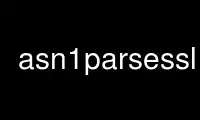
This is the command asn1parsessl that can be run in the OnWorks free hosting provider using one of our multiple free online workstations such as Ubuntu Online, Fedora Online, Windows online emulator or MAC OS online emulator
PROGRAM:
NAME
asn1parse - ASN.1 parsing tool
SYNOPSIS
openssl asn1parse [-inform PEM|DER] [-in filename] [-out filename] [-noout] [-offset
number] [-length number] [-i] [-oid filename] [-dump] [-dlimit num] [-strparse offset]
[-genstr string] [-genconf file]
DESCRIPTION
The asn1parse command is a diagnostic utility that can parse ASN.1 structures. It can also
be used to extract data from ASN.1 formatted data.
OPTIONS
-inform DER|PEM
the input format. DER is binary format and PEM (the default) is base64 encoded.
-in filename
the input file, default is standard input
-out filename
output file to place the DER encoded data into. If this option is not present then no
data will be output. This is most useful when combined with the -strparse option.
-noout
don't output the parsed version of the input file.
-offset number
starting offset to begin parsing, default is start of file.
-length number
number of bytes to parse, default is until end of file.
-i indents the output according to the "depth" of the structures.
-oid filename
a file containing additional OBJECT IDENTIFIERs (OIDs). The format of this file is
described in the NOTES section below.
-dump
dump unknown data in hex format.
-dlimit num
like -dump, but only the first num bytes are output.
-strparse offset
parse the contents octets of the ASN.1 object starting at offset. This option can be
used multiple times to "drill down" into a nested structure.
-genstr string, -genconf file
generate encoded data based on string, file or both using ASN1_generate_nconf(3)
format. If file only is present then the string is obtained from the default section
using the name asn1. The encoded data is passed through the ASN1 parser and printed
out as though it came from a file, the contents can thus be examined and written to a
file using the out option.
OUTPUT
The output will typically contain lines like this:
0:d=0 hl=4 l= 681 cons: SEQUENCE
.....
229:d=3 hl=3 l= 141 prim: BIT STRING
373:d=2 hl=3 l= 162 cons: cont [ 3 ]
376:d=3 hl=3 l= 159 cons: SEQUENCE
379:d=4 hl=2 l= 29 cons: SEQUENCE
381:d=5 hl=2 l= 3 prim: OBJECT :X509v3 Subject Key Identifier
386:d=5 hl=2 l= 22 prim: OCTET STRING
410:d=4 hl=2 l= 112 cons: SEQUENCE
412:d=5 hl=2 l= 3 prim: OBJECT :X509v3 Authority Key Identifier
417:d=5 hl=2 l= 105 prim: OCTET STRING
524:d=4 hl=2 l= 12 cons: SEQUENCE
.....
This example is part of a self signed certificate. Each line starts with the offset in
decimal. d=XX specifies the current depth. The depth is increased within the scope of any
SET or SEQUENCE. hl=XX gives the header length (tag and length octets) of the current
type. l=XX gives the length of the contents octets.
The -i option can be used to make the output more readable.
Some knowledge of the ASN.1 structure is needed to interpret the output.
In this example the BIT STRING at offset 229 is the certificate public key. The contents
octets of this will contain the public key information. This can be examined using the
option -strparse 229 to yield:
0:d=0 hl=3 l= 137 cons: SEQUENCE
3:d=1 hl=3 l= 129 prim: INTEGER :E5D21E1F5C8D208EA7A2166C7FAF9F6BDF2059669C60876DDB70840F1A5AAFA59699FE471F379F1DD6A487E7D5409AB6A88D4A9746E24B91D8CF55DB3521015460C8EDE44EE8A4189F7A7BE77D6CD3A9AF2696F486855CF58BF0EDF2B4068058C7A947F52548DDF7E15E96B385F86422BEA9064A3EE9E1158A56E4A6F47E5897
135:d=1 hl=2 l= 3 prim: INTEGER :010001
NOTES
If an OID is not part of OpenSSL's internal table it will be represented in numerical form
(for example 1.2.3.4). The file passed to the -oid option allows additional OIDs to be
included. Each line consists of three columns, the first column is the OID in numerical
format and should be followed by white space. The second column is the "short name" which
is a single word followed by white space. The final column is the rest of the line and is
the "long name". asn1parse displays the long name. Example:
"1.2.3.4 shortName A long name"
EXAMPLES
Parse a file:
openssl asn1parse -in file.pem
Parse a DER file:
openssl asn1parse -inform DER -in file.der
Generate a simple UTF8String:
openssl asn1parse -genstr 'UTF8:Hello World'
Generate and write out a UTF8String, don't print parsed output:
openssl asn1parse -genstr 'UTF8:Hello World' -noout -out utf8.der
Generate using a config file:
openssl asn1parse -genconf asn1.cnf -noout -out asn1.der
Example config file:
asn1=SEQUENCE:seq_sect
[seq_sect]
field1=BOOL:TRUE
field2=EXP:0, UTF8:some random string
Use asn1parsessl online using onworks.net services
